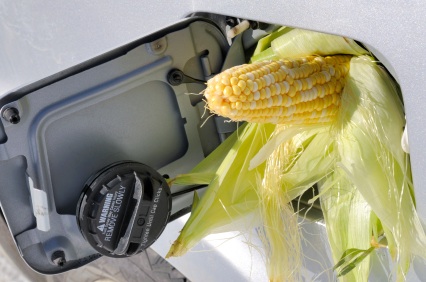 What’s that in your gas tank?This is a blog post about the intersection of a bad idea and lots of cash–your cash.
What’s that in your gas tank?This is a blog post about the intersection of a bad idea and lots of cash–your cash.
The bad idea is this: growing crops to ferment and distill them into ethanol for internal combustion engines. A few days ago, the EPA revealed that by its calculations, use of corn-based ethanol will actually raise greenhouse gas emissions over the next 30 years compared to gasoline. And then Friday, Science published a paper by Stanford academics claiming that it makes much more sense to burn corn to produce energy for electric cars than it does to convert corn into ethanol. And it’s not even close. Get this:
Bioelectricity was the clear winner in the transportation-miles-per-acre comparison, regardless of whether the energy was produced from corn or from switchgrass, a cellulose-based energy crop.
Did you catch that? “[W]hether the energy was produced from corn or from switchgrass…” That means that even cellulosic ethanol, which the industry gas been holding up as a just-around-the-corner panacea for 20 years, looks like a bad idea. The analysis strongly suggests that the government should be pushing the auto industry in the direction of electric cars, not ethanol-guzzling flex fuel ones.
The energy from an acre of switchgrass used to power an electric vehicle would prevent or offset the release of up to 10 tons of CO2 per acre, relative to a similar-sized gasoline-powered car. Across vehicle types and different crops, this offset averages more than 100% larger for the bioelectricity than for the ethanol pathway. Bioelectricity also offers more possibilities for reducing greenhouse gas emissions through measures such as carbon capture and sequestration, which could be implemented at biomass power stations but not individual internal combustion vehicles.
So that’s the bad idea. Where’s the cash? Check out this report (PDF) from Friends of the Earth. Under the Renewable Fuel Standard, the federal government mandates that 36 billion gallons of biofuel be mixed into liquid fuel supplies by 2022. (Currently, the industry is churning out around 9 billion gallons.) The mandate is backed by lucrative tax credits. As a result, “Subsidies to biofuels between 2008 and 2022 are likely to total a staggering $420 billion.” The report adds, chillingly, “If the mandate is expanded, as President Obama proposed during last year’s campaign, this number could more than double.”
Let me get this straight. In a time of escalating climate chaos and severe budget deficits, we have nearly half a trillion dollars — and maybe double that amount — to throw at an idea that’s looking increasingly imbecilic?



